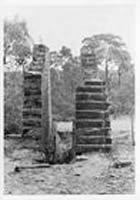Cultural mining landscapes
This entry seeks to place cultural landscapes on a par with more recognised forms of historical evidence. The term cultural landscapes refers to the remnants of the built environments established as a consequence of gold discoveries and the collateral visual, oral, and documentary material that assists in their interpretation. The study of cultural landscapes is especially useful for any historical analysis of the Mount Alexander and Ballarat diggings.



